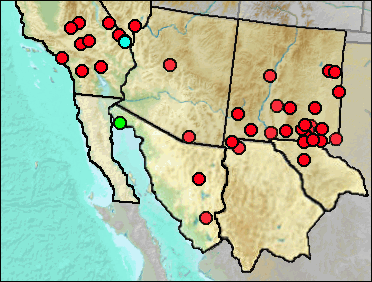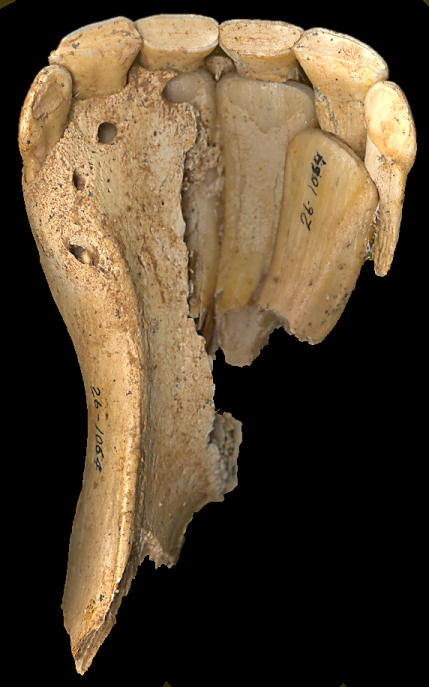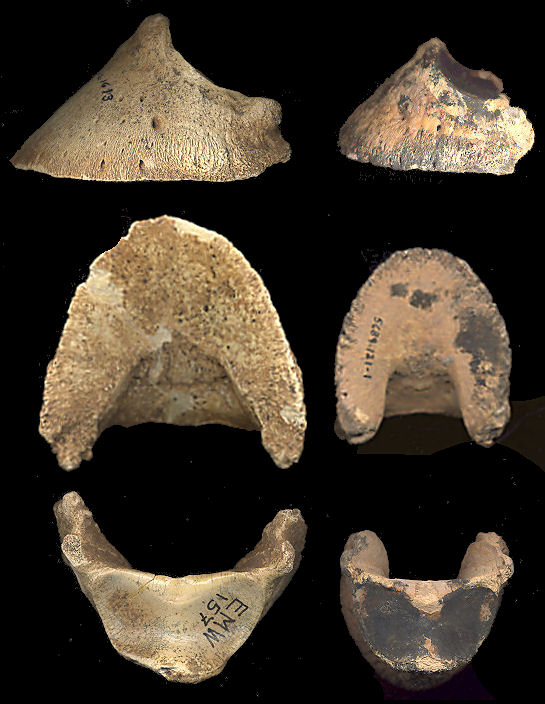Class Mammalia
Order Perissodactyla
Family Equidae
Equidae—Family Equidae // Equidae sp.—Horses // Equus sp. (small)—Small Horse // Equus sp (large)—Large Horse // Equus calobatus—Stilt-legged Onager // Equus conversidens—Mexican Horse // Equus cumminsii—Cummings' Ass // Equus enormis—Enormous Horse // Equus fraternus—Fraternal Horse // Equus giganteus—Giant Horse // Equus occidentalis—Western Horse // Equus pacificus—Pacific Horse // Equus (Plesippus) sp.—American Zebra // Equus (Plesippus) francescana—Francescana Zebra // Equus (Plesippus) simplicidens—American Zebra // Equus Species A—Unidentified Equus // Haringtonhippus francisci—Harington's Stilt-legged Horse

Synonyms. Equus alaskae, Equus semiplicatus.
Scott (1996) noted that there are three incompatible morphological concepts of Equus conversidens in the literature: a small, stout-legged horse with a lack of infundibulae in the lower incisors and with the molar ectoflexids not entering into the metaconid-metastylid isthmus; a horse with similar morphology but having infundibulae in the lower incisors; and a horse similar to the latter but having stilt-legged metapodials. The first definition is that followed here and by Harris and Porter (1980) among a number of other researchers.
 The nomenclatural
position of the medium-small horse with only moderately slender metapodials (ratio of the length to
the proximal width of the metacarpal generally less than 5.0 and that of the metatarsal less than
6.0) has been all over the place, as noted above. Winans (1985) treated E. conversidens
as a nomen nudum since it was named solely on the basis of dental characters, which she found
non-diagnostic. However, the name has been widely used. The name E. alaskae
has been used in the literature based on the treatment of species or species groups of Winans
(1985, 1989). Barrón-Ortiz et al. (2017) used the name Equus conversidens for the non-caballine North American horses (the New World Stilt-legged horses of Weinstock et al. [2005] and presumably Haringtonhippus francisci of Heintzman et al. [2017]). I have chosen to retain the name E. conversidens for this medium-small, extinct horse.
The nomenclatural
position of the medium-small horse with only moderately slender metapodials (ratio of the length to
the proximal width of the metacarpal generally less than 5.0 and that of the metatarsal less than
6.0) has been all over the place, as noted above. Winans (1985) treated E. conversidens
as a nomen nudum since it was named solely on the basis of dental characters, which she found
non-diagnostic. However, the name has been widely used. The name E. alaskae
has been used in the literature based on the treatment of species or species groups of Winans
(1985, 1989). Barrón-Ortiz et al. (2017) used the name Equus conversidens for the non-caballine North American horses (the New World Stilt-legged horses of Weinstock et al. [2005] and presumably Haringtonhippus francisci of Heintzman et al. [2017]). I have chosen to retain the name E. conversidens for this medium-small, extinct horse.
Several specimens of lower incisors assigned by Harris and Porter (1980) are available and lack an infundibulum. The illustrated specimen (Fig. 1) was referred by Harris and Porter (1980) to E. occidentalis, but since has been compared with a specimen of E. conversidens of similar age and appears to represent the latter species. Width at the di3s is 67.8 mm. The specimen is the same as drawn as Fig. 6 J in Harris and Porter (1980).
Fig. 1. Anterior lower jaw of Equus showing the lack of an infundibulum in i1 and i2 and possibly in the deciduous incisors, although di3 is slightly scooped. This has been listed (Harris and Porter 1980) as E. occidentalis, but in comparison with a specimen of E. conversidens of similar age appears to pertain to this species. UTEP 26-1064.
Winans (1989) considered the small horses of Dry Cave, where she characterized E. conversidens, as representative of the Equus alaskae group, and Harris (1993c) listed it under that name.
Tebedge (1988) seemed to indicate that the Dark Canyon Cave specimens fall into this taxon, but being unsure of the nomenclature, merely listed it as Equus sp. Since UTEP horse material from Dark Canyon Cave is identified as E. conversidens, Tebedge's material is recorded as the same.
The third phalanx of this species differs notably from that of E. scotti (Fig. 2), presumably not only as a result of size differences, but of adaptations to different environments. The third phalanx of E. conversidens is very similar to that of Equus asinus.
Fig. 2. Third phalanges of Equus scotti (left) and E. conversidens.

In their tables of measurements and figures, Harris and Porter (1980) listed various sites within Dry Cave only by site number; they are cited here by the site name.
The youngest dates cited by Fiedel (2009) for the species are 11,330 ± 70 and 10,870 ± 45 BP.
Sites.
Quaternary: Nash Draw (Harris 1993c: ?).
Pleistocene: Mockingbird Gap (Morgan and Lucas 2005); Sapillo Creek (Wolberg 1980); Tucumcari (Morgan and Lucas 2005).
Irvingtonian: El Golfo (Croxen et al. 2007: cf.).
Irvingtonian/Rancholabrean: Manix Lake (Jefferson 1991b: cf.).
Early Rancholabrean: Shoshone Zoo (Jefferson 2014).
Rancholabrean: Badlands Ranch (Morgan and Lucas 2005); Bitter Springs Playa (Jefferson 1991b: cf.); Goler Gulch (Jefferson 2014); Pinto Basin (Jefferson 1991c: cf.); Piute Valley (Jefferson 1991b: cf., withdrawn [Jefferson 2014]); Rancho de Enmedio (White et al. 2010); Roswell (Morgan and Lucas 2005); Starvation Draw (Morgan and Lucas 2005); United Energy Solar Ponds (Jefferson 1991b: cf.); Valley Wells (Jefferson 1991b: cf., withdrawn).
Late Rancholabrean: Mountain Breeze (Morgan and Lucas 2005).
Early Wisconsin: Stevens Lake (Jefferson 1991b).
Mid Wisconsin: Papago Springs Cave (Czaplewski and Mead et al. 1999); Pendejo Cave (Harris 2003); U-Bar Cave (Harris 1987).
Mid/Late Wisconsin: Big Manhole Cave (Harris 1993c; UTEP); Dark Canyon Cave (Tebedge 1988); Diamond Valley (Springer et al. 2009); Hampton Court (Harris and Porter 1980); NW Talus Slope (Harris and Porter 1980); Pit N&W Animal Fair (Harris 1993c); Rancho La Brea (Stock and Harris 1992).
Mid/Late Wisconsin/Holocene: Shelter Cave (Harris data); Sierra Diablo Cave (UTEP).
Late Wisconsin: Algerita Blossom Cave (Harris 1993c); Animal Fair (Harris 1993c; Harris and Porter 1980); Antelope Cave (Reynolds, Reynolds, Bell, and Pitzer 1991); Balcony Room (Harris 1993c); Bison Chamber (Harris 1989); Blackwater Draw Fauna (Lundelius 1972); Burnet Cave (Harris 1993c; Harris data); Camel Room (Harris 1993c: cf.); Charlies Parlor (Harris and Porter 1980); China Lake (Jefferson 1991b: cf.); Conkling Cavern (Harris data); Fain Ranch (Pasenko and Agenbroad 2012: cf.); Gypsum Cave (Jefferson et al. 2015); Harris' Pocket (Harris and Porter 1980); Howell's Ridge Cave (Harris 1993c:cf.); Human Corridor (Harris and Porter 1980); Isleta Cave No. 2 (Harris 1993c: cf.); Jal Horse Quarry (Schultz 1943); Kokoweef Cave (Reynolds, Reynolds, et al. 1991); Mystery Light Cave (this volume: cf.); Omega Cave (Harris 1993c); Pendejo Cave (Harris 2003); Salt Creek (UTEP: cf.); Stalag 17 (Harris and Porter 1980); TT II (Harris and Porter 1980); U-Bar Cave 13-14 ka (Harris 1989); U-Bar Cave 14-15 ka (Harris 1989: cf.); Williams Cave (Ayer 1936).
Literature. Ayer 1936; Barrón-Ortiz 2016; Croxen et al. 2007; Czaplewski and Mead et al. 1999; Fiedel 2009; Harris 1987, 1989, 1993c, 2003; Harris and Porter 1980; Heintzman et al. 2007; Jefferson 1991b, 1991c, 2014; Jefferson et al. 2015; Lundelius 1972; Morgan and Lucas 2005; Pasenko and Agenbroad 2012; Reynolds, Reynolds, et al. 1991; Reynolds, Reynolds, Bell, and Pitzer 1991; Schultz 1943; Scott 1996; Springer et al. 2009); Stock and Harris 1992); Tebedge 1988; White et al. 2010; Weinstock et al. 2005; Winans 1985, 1989; Wolberg 1980.
Last Update: 7 Jul 2018